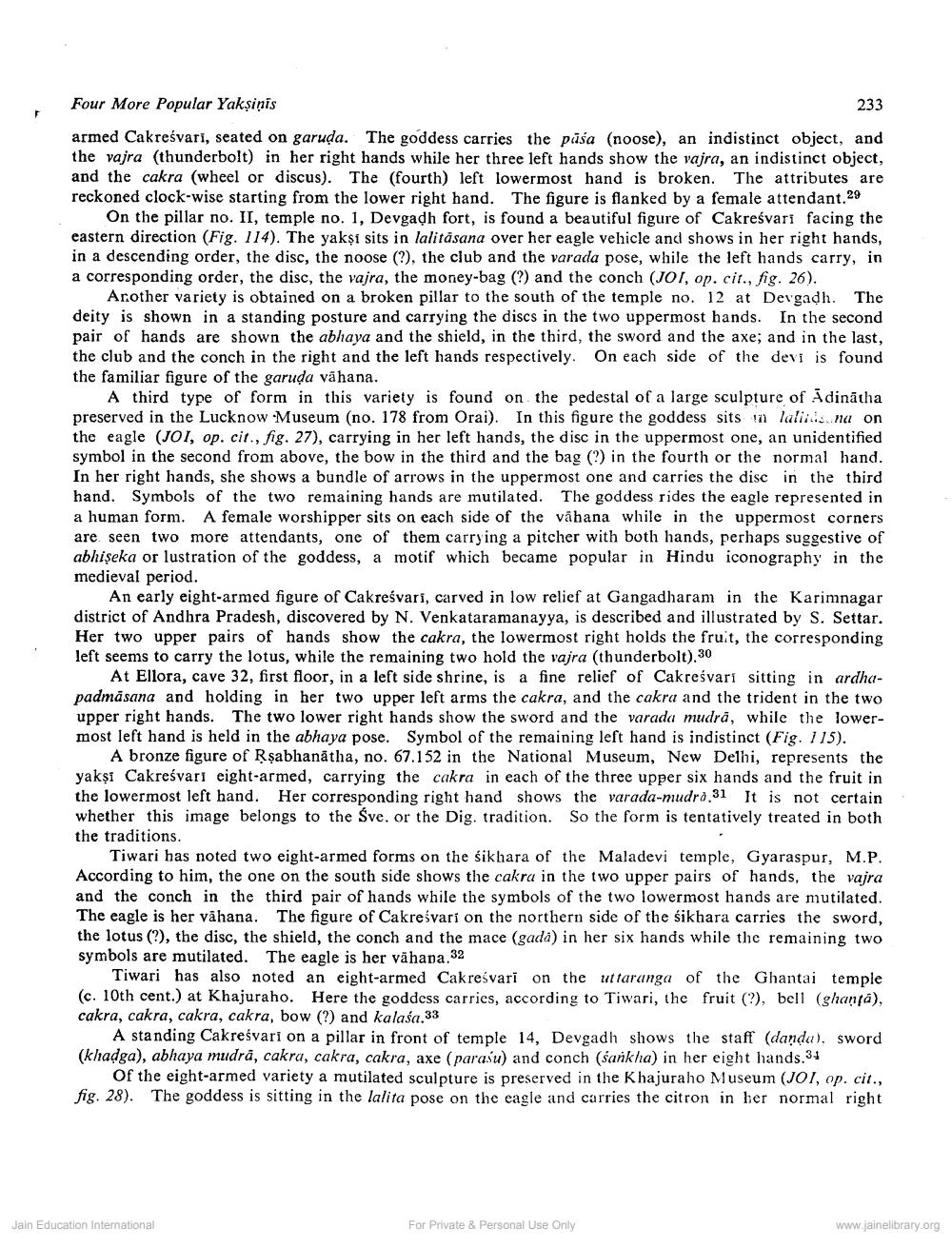________________
Four More Popular Yaksinis
233 armed Cakreśvari, seated on garuda. The goddess carries the paša (noose), an indistinct object, and the vajra (thunderbolt) in her right hands while her three left hands show the vajra, an indistinct object, and the cakra (wheel or discus). The (fourth) left lowermost hand is broken. The attributes are reckoned clock-wise starting from the lower right hand. The figure is flanked by a female attendant.29
On the pillar no. II, temple no. 1, Devgadh fort, is found a beautiful figure of Cakreśvari facing the eastern direction (Fig. 114). The yakși sits in lalitasana over her eagle vehicle and shows in her right hands, in a descending order, the disc, the noose (?), the club and the varada pose, while the left hands carry, in a corresponding order, the disc, the vajra, the money-bag (?) and the conch (JOI, op. cit., fig. 26).
Arother variety is obtained on a broken pillar to the south of the temple no. 12 at Devgadh. The deity is shown in a standing posture and carrying the discs in the two uppermost hands. In the second pair of hands are shown the abhaya and the shield, in the third, the sword and the axe, and in the last, the club and the conch in the right and the left hands respectively. On each side of the devi is found the familiar figure of the garuda vähana.
A third type of form in this variety is found on the pedestal of a large sculpture of Adinātha preserved in the Lucknow Museum (no. 178 from Orai). In this figure the goddess sits in lalinis na on the eagle (JOI, op. cit., fig. 27), carrying in her left hands, the disc in the uppermost one, an unidentified symbol in the second from above, the bow in the third and the bag (?) in the fourth or the normal hand. In her right hands, she shows a bundle of arrows in the uppermost one and carries the disc in the third hand. Symbols of the two remaining hands are mutilated. The goddess rides the eagle represented in a human form. A female worshipper sits on each side of the vāhana while in the uppermost corners are seen two more attendants, one of them carrying a pitcher with both hands, perhaps suggestive of abhişeka or lustration of the goddess, a motif which became popular in Hindu iconography in the medieval period.
An early eight-armed figure of Cakreśvari, carved in low relief at Gangadharam in the Karimnagar district of Andhra Pradesh, discovered by N. Venkataramanayya, is described and illustrated by S. Settar. Her two upper pairs of hands show the cakra, the lowermost right holds the fruit, the corresponding left seems to carry the lotus, while the remaining two hold the vajra (thunderbolt),30
At Ellora, cave 32, first floor, in a left side shrine, is a fine relief of Cakreśvari sitting in ardhapadmasana and holding in her two upper left arms the cakra, and the cakra and the trident in the two upper right hands. The two lower right hands show the sword and the varada mudrå, while the lowermost left hand is held in the abhaya pose. Symbol of the remaining left hand is indistinct (Fig. 115).
A bronze figure of Rsabhanátha, no. 67.152 in the National Museum, New Delhi, represents the yakşi Cakreśvari eight-armed, carrying the cakra in each of the three upper six hands and the fruit in the lowermost left hand. Her corresponding right hand shows the varada-mudro.31 It is not certain whether this image belongs to the Sve. or the Dig. tradition. So the form is tentatively treated in both the traditions.
Tiwari has noted two eight-armed forms on the sikhara of the Maladevi temple, Gyaraspur, M.P. According to him, the one on the south side shows the cakra in the two upper pairs of hands, the vajra and the conch in the third pair of hands while the symbols of the two lowermost hands are mutilated. The eagle is her vähana. The figure of Cakreśvari on the northern side of the sikhara carries the sword, the lotus (?), the disc, the shield, the conch and the mace (gada) in her six hands while the remaining two symbols are mutilated. The eagle is her vähana 32
Tiwari has also noted an eight-armed Cakreśvari on the uttaranga of the Ghantai temple (c. 10th cent.) at Khajuraho. Here the goddess carries, according to Tiwari, the fruit (?), bell (ghanta), cakra, cakra, cakra, cakra, bow (?) and kalasa.33
A standing Cakreśvari on a pillar in front of temple 14. Devgadh shows the staff (danda). sword (khadga), abhaya mudra, cakra, cakra, cakra, axe (parasu) and conch (sarkha) in her eight hands.34
Of the eight-armed variety a mutilated sculpture is preserved in the Khajuraho Museum (J01, op. cit., fig. 28). The goddess is sitting in the lalita pose on the eagle and carries the citron in her normal right
Jain Education International
For Private & Personal Use Only
www.jainelibrary.org




